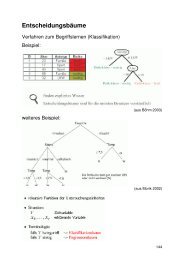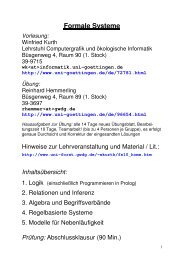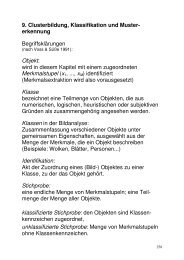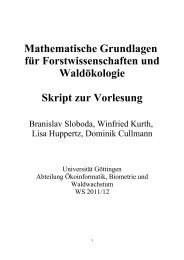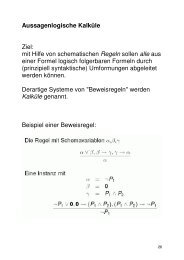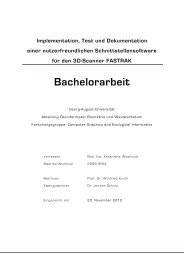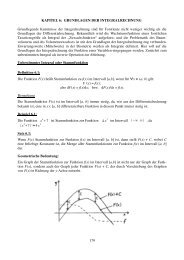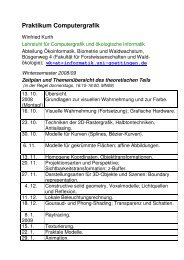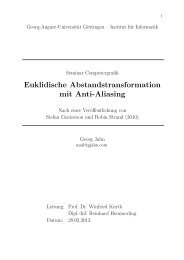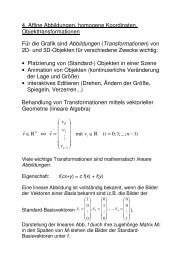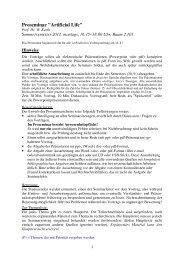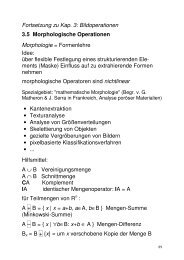Summer School Modelling and Simulation with GroIMP
Summer School Modelling and Simulation with GroIMP
Summer School Modelling and Simulation with GroIMP
You also want an ePaper? Increase the reach of your titles
YUMPU automatically turns print PDFs into web optimized ePapers that Google loves.
in cooperation <strong>with</strong><br />
Georg-August University of Göttingen<br />
Chair for Computer Graphics <strong>and</strong> Ecological Informatics<br />
Büsgenweg 4, 37077 Göttingen, Germany<br />
http://www.uni-goettingen.de/en/67072.html<br />
Third announcement:<br />
International <strong>Summer</strong> <strong>School</strong><br />
"<strong>Modelling</strong> <strong>and</strong> <strong>Simulation</strong> <strong>with</strong> <strong>GroIMP</strong>"<br />
(combined <strong>with</strong> the fourth <strong>GroIMP</strong> user <strong>and</strong> developer meeting<br />
<strong>and</strong> including a workshop "Rule-based 3-d models of plants <strong>and</strong> other objects")<br />
partially funded by the German Academic Exchange Service<br />
in the programme "DAAD Ostpartnerschaften"<br />
Date: 27 September - 1 st October 2010<br />
Location:<br />
XL <strong>and</strong> <strong>GroIMP</strong> tutorial for beginners:<br />
Workshop:<br />
Tutorial for advanced XL <strong>and</strong> <strong>GroIMP</strong> users:<br />
<strong>GroIMP</strong> user <strong>and</strong> developer meeting:<br />
27 Sept., 9:00 h – 28 Sept., 18:15 h<br />
29 Sept., 9:00 h – 18:15 h<br />
30 Sept., 9:00 h – 1 st Oct., 12:00 h<br />
30 Sept., 13:30 h – 14:00 h<br />
University of Göttingen, Department Ecoinformatics, Biometrics <strong>and</strong><br />
Forest Growth, Büsgenweg 4, 37077 Göttingen, Germany<br />
Room CIP I<br />
Accommodation in Göttingen can be found under<br />
http://www.goettingen-tourismus.de/staticsite/staticsite.php?menuid=174&topmenu=174&keepmenu=inactive.<br />
Contact: Winfried Kurth, Chair for Computer Graphics <strong>and</strong> Ecological Informatics<br />
Georg-August University of Göttingen, Büsgenweg 4, 37077 Göttingen, Germany<br />
Tel. +49–551–399715, Fax +49–551–393465, E-mail wk(at)informatik.uni-goettingen.de<br />
Time schedule<br />
(red: contributions not yet listed in the second announcement)<br />
Monday, 27 Sept. 2010<br />
9:00 Opening, Introduction,<br />
preparatory meeting for students who need certified ECTS credits<br />
9:15 W. Kurth: Introduction to rule-based programming, L-systems <strong>and</strong> XL<br />
10:15 Coffee break<br />
10:30 W. Kurth: Some basic examples in XL (part 1)<br />
11:15 Simple branched structures modelled <strong>with</strong> XL (team work)<br />
12:00 Lunch<br />
13:30 W. Kurth: Basic examples in XL (part 2)<br />
14:30 R. Hemmerling <strong>and</strong> K. Smoleňová: How to model a daisy in 1/2 hour<br />
15:00 Simple rendered plants modelled <strong>with</strong> XL (team work)<br />
15:45 Coffee break<br />
16:15 W. Kurth: Some basic examples in XL (part 3)<br />
17:00 Coffee break <strong>and</strong>/or Questions <strong>and</strong> answers<br />
17:30 M. Henke: A closer look at some examples from the grogra.de gallery<br />
- ca. 18:30<br />
1
Tuesday, 28 Sept.<br />
9:00 G. Buck-Sorlin: How to implement a simple FSPM<br />
10:00 W. Kurth: Basic examples in XL (part 4)<br />
10:45 Coffee break<br />
11:15 W. Kurth: Interpretive rules <strong>and</strong> instantiation rules<br />
11:45 Using instantiation rules (team work)<br />
12:15 Lunch<br />
13:45 W. Kurth: <strong>Modelling</strong> point patterns, competition <strong>and</strong> plant-herbivore interaction<br />
14:30 Experiments <strong>with</strong> point patterns or spreading animals (team work)<br />
15:15 Coffee break<br />
15:45 K. Smoleňová: <strong>Modelling</strong> morphological features of trees in XL<br />
16:45 R. Hemmerling: Working <strong>with</strong> graphs containing cycles<br />
17:30 Questions <strong>and</strong> answers, evaluation session of beginners' tutorial<br />
- ca. 18:00<br />
Wednesday, 29 Sept. 2010<br />
Workshop "Rule-based 3-d models of plants <strong>and</strong> other objects":<br />
9:00 J. Evers: Simulating hormonal regulation of bud break modulated by light quality<br />
9:45 P. Favre: A model of resource allocation in plant growth<br />
10:30 Coffee break<br />
11:00 K. Smoleňová <strong>and</strong> G. Buck-Sorlin: An FSPM of barley including the allocation <strong>and</strong><br />
effects of carbon, nitrogen <strong>and</strong> gibberellic acid<br />
12:00 Lunch<br />
13:30 R. van Daelen: A tomato model<br />
14:15 P. de Visser <strong>and</strong> G. Buck-Sorlin: Testing the effect of different light node types <strong>and</strong><br />
shaders on the simulation of light absorption <strong>and</strong> photosynthesis of a tomato crop in a<br />
greenhouse setting<br />
15:00 M. Henke: A first step towards a generic FSPM<br />
15:45 Coffee break<br />
16:15 J. Dérer: On animating artificial life forms<br />
or P. Masters <strong>and</strong> K.-P. Zauner: Robotropism: Distributed Control of Plants<br />
17:00 G. Buck-Sorlin: SIMPLER: An FSPM coupling shoot production <strong>and</strong> human<br />
interaction <strong>with</strong> the structure, morphogenesis, photosynthesis <strong>and</strong> light environment in cutrose<br />
17:45 All: Conclusions <strong>and</strong> future projects<br />
- 18:15<br />
19:00 <strong>Summer</strong> <strong>School</strong> Dinner<br />
Thursday, 30 Sept.<br />
9:00 R. Hemmerling: A model of a mixed st<strong>and</strong>, including competition for light<br />
10:00 W. Kurth: <strong>Modelling</strong> above- <strong>and</strong> below-ground competition together<br />
10:45 Coffee break<br />
11:15 O. Kniemeyer: The XL plugin for the 3-d modeller Cinema 4D<br />
12:00 Lunch<br />
13:30 <strong>GroIMP</strong> User <strong>and</strong> developer meeting<br />
14:00 P. Surovy: Introduction to electromagnetic 3-d digitization<br />
15:15 Coffee break<br />
15:45 R. Hemmerling: How to control parameter values using <strong>GroIMP</strong>'s GUI<br />
16:15 Questions <strong>and</strong> answers session (plenary)<br />
17:00 Questions <strong>and</strong> answers team sessions<br />
2
- ca. 18:00<br />
Friday, 1 st October<br />
9:15 G. Buck-Sorlin: Large functional-structural crop models in XL. Design – maintenance<br />
– pitfalls<br />
10:15 Coffee break<br />
10:45 R. Hemmerling: Tracking the solution of an ODE using monitor functions<br />
11:45 Evaluation session of advanced tutorial<br />
- 12:00<br />
End of summer school: 1 st October, 12:00 h<br />
Abstracts of workshop contributions<br />
Gerhard Buck-Sorlin (Wageningen UR):<br />
SIMPLER: An FSPM coupling shoot production <strong>and</strong> human interaction <strong>with</strong> the<br />
structure, morphogenesis, photosynthesis <strong>and</strong> light environment in cut-rose<br />
The production of cut-rose involves a specific combination of plant material, management<br />
practice <strong>and</strong> environment. Cut-roses are grown in highly controlled greenhouses. Amount of<br />
light intercepted <strong>and</strong> subsequent assimilate production depend on numerous factors (canopy<br />
structure, plant arrangement, greenhouse construction, or season). The Functional-Structural<br />
model of cut-rose (implemented in <strong>GroIMP</strong>/XL) presented here attempts to tackle the<br />
complexity of the combination of these factors in one modelling system. This model will be<br />
the departure point for both an extensible research platform for rose physiology <strong>and</strong> a<br />
decision-support tool for growers, breeders <strong>and</strong> consultants.<br />
Pieter de Visser <strong>and</strong> Gerhard Buck-Sorlin (Wageningen UR):<br />
Testing the effect of different light node types <strong>and</strong> shaders on the simulation of light<br />
absorption <strong>and</strong> photosynthesis of a tomato crop in a greenhouse setting.<br />
A 3D model of a greenhouse construction is built in <strong>GroIMP</strong>, including lamps, plants <strong>and</strong><br />
substrate slabs. The challenge is to correctly simulate the light distribution <strong>and</strong> light absorption<br />
in the crop canopy. The effect of using different light nodes types for the diffuse sky,<br />
direct sunlight <strong>and</strong> lamps on the fate of light is evaluated. Apart of variations in the radiation<br />
intensities, the differences between absorbed <strong>and</strong> sensed radiation <strong>and</strong> between different<br />
types of shaders are presented. Finally, the prospects to use <strong>GroIMP</strong> for testing illumination<br />
strategies in horticulture are discussed.<br />
Jan-Anton Dérer (MediaDesign University, Berlin):<br />
On animating artificial life forms<br />
Jochem Evers (Wageningen UR):<br />
Simulating hormonal regulation of bud break modulated by light quality<br />
Bud break in plants is regulated by endogenous hormonal signals <strong>and</strong> environmental factors<br />
such as light. In this study, the objective was to get insight into hormonal regulation of bud<br />
break as modulated by the red/far-red ratio of the incoming light. To this end, conceptual<br />
modelling of hormone signalling related to bud break was combined <strong>with</strong> computational<br />
modelling of light signalling <strong>with</strong>in a growing plant structure. Model species was Arabidopsis,<br />
<strong>and</strong> model implementation was done in XL using the <strong>GroIMP</strong> platform.<br />
3
Patrick Favre (University of Fribourg):<br />
A model of resource allocation in plant growth<br />
Our study is to underst<strong>and</strong> the adaptiveness of allocations resources for rosette plant growth.<br />
A mathematical model containing the shoot <strong>and</strong> the root compartments, was developed to<br />
integrate the physical <strong>and</strong> physiological properties for the production of sugar by the leaves,<br />
the uptake of phosphate by the roots <strong>and</strong> the transport of these substances to each<br />
compartment. Our equations were then incorporated in a Lindenmayer-systems model <strong>with</strong><br />
multiple-compartments using the Java-based <strong>GroIMP</strong> software. The 3D structure allows to<br />
calculate light interception, to take into account the root ramification <strong>and</strong> to make contact <strong>with</strong><br />
arbuscular mycorrhizae in the case of Petunia hybrida plants in symbiotic associations. This<br />
model will also be used to study growth of Arabidopsis thaliana mutants.<br />
Michael Henke (University of Göttingen):<br />
A first step towards a generic FSPM<br />
Paul Masters <strong>and</strong> Klaus-Peter Zauner (University of Southampton, UK):<br />
Robotropism: Distributed Control of Plants<br />
We envisage electronic controllers attached to plants to cause them to grow in desired<br />
directions. Rather like robots <strong>with</strong> plants as their bodies, the controllers may communicate<br />
<strong>and</strong> cooperate to encourage plants to grow along dynamically adjusted trajectories into predefined<br />
complex structures. Light, gravity <strong>and</strong> touch sensitivity are included into a model of a<br />
climbing plant. A physics engine is introduced to <strong>GroIMP</strong> as a way of modelling gravitational<br />
effects on the plants. The possibilities for growing simple structures are explored.<br />
Katarína Smoleňová <strong>and</strong> Gerhard Buck-Sorlin (University of Göttingen / Wageningen UR):<br />
An FSPM of barley including the allocation <strong>and</strong> effects of carbon, nitrogen <strong>and</strong><br />
gibberellic acid<br />
Raymond van Daelen (Keygene NV, Dept. Bio-Informatics, Wageningen):<br />
A tomato model<br />
The architecture of tomato is a crucial aspect for the production of tomatoes, for instance<br />
time <strong>and</strong> placing of inflorescences, structure of trusses, number of leaves between trusses,<br />
formation of side shoots, etc. Keygene is interested in analyzing mechanisms involved in<br />
determining these aspects. Even though many genes are known, such as SFT, SP, AN, BL,<br />
FA, S, J, F, which somehow affect flowering <strong>and</strong>/or truss shapes, the interactions between<br />
these genes, if any, is poorly known. We are developing a functional-structural plant model to<br />
analyze <strong>and</strong> possibly elucidate the potential interactions between these genes, to explain the<br />
mechanisms that determine the meristem fate <strong>with</strong> respect to vegetative growth <strong>and</strong> switch<br />
to flowering. We will present the current state of the developed model, which was created<br />
using <strong>GroIMP</strong>.<br />
4



